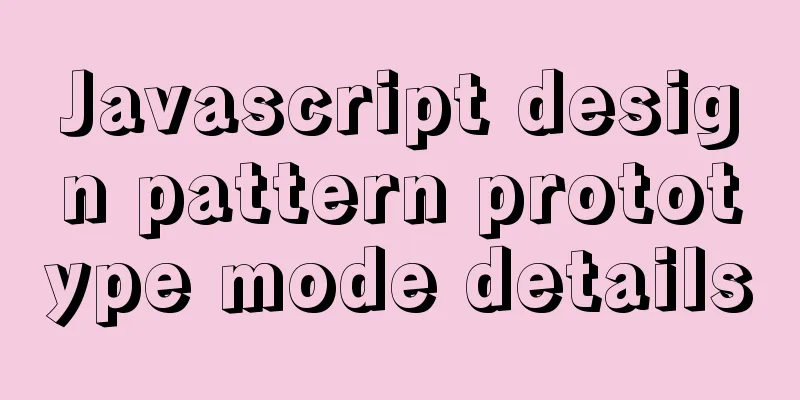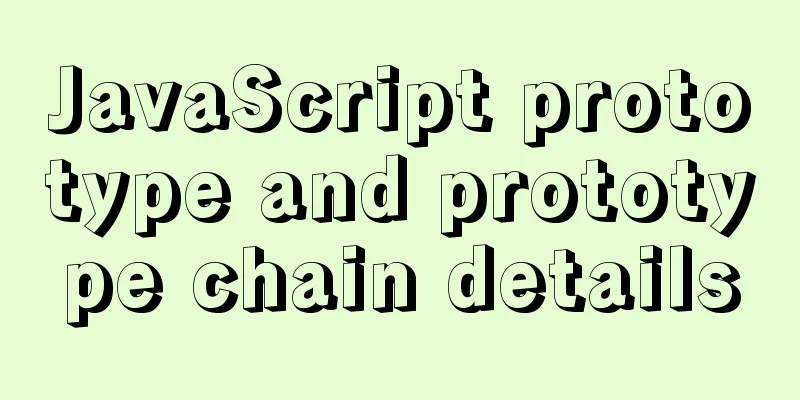Javascript design pattern prototype mode details

1. Prototype modeThe prototype pattern is used to improve performance, reduce memory usage, and reuse code by sharing the properties and methods of an object prototype when creating an object. Example 1
function Person(name) {
this.name = name;
this.config = {
a: "1",
b: "2",
};
this.hello = function () {
console.info("hello");
};
}
If you need to create 100 instances using the above code, you will need to create 100 Therefore, we can perform oil optimization by extracting common codes.
const config = {
a: "1",
b: "2",
};
const hello = function () {
console.info("hello");
};
function Person(name) {
this.name = name;
this.config = config;
this.hello = hello
}
This way, no matter how many Person objects are created, only one Therefore, optimization can be performed through prototyping.
function Person() {}
var p = new Person();
The prototype diagram of this function when creating an instance is as follows:
Example 2
function Person(name) {
this.name = name;
this.config = {
a: "1",
b: "2",
};
this.hello = function () {
console.info("hello");
};
}
//This method will rewrite the prototype, causing the constructor to be lost and become Object().
//You can use Person.prototype.xx=yy to write, or re-specify Person.prototype.constructor=Person
Person.prototype = {
version: 1.0,
say: function (arg) {
console.info(`${this.name} say ${arg}`);
},
constructor: Person,
};
var p1 = new Person("p1");
var p2 = new Person("p2");
console.info(p1.config == p2.config); //false
console.info(p1.hello == p2.hello); //false
console.info(p1.say === p2.say); //true
p1.say("qq");
p2.say("qq");
console.info(p1.version === p2.version); //true
console.info(p1.version);
The prototype diagram of this function when creating an instance is as follows:
Example 3
function Person(name) {
this.name = name;
this.config = {
a: "1",
b: "2",
};
this.hello = function () {
console.info("hello");
};
}
//This method will rewrite the prototype, causing the constructor to be lost and become Object()
Person.prototype = {
version: 1.0,
say: function (arg) {
console.info(`${this.name} say ${arg}`);
},
};
function PersonA(name) {
Person.call(this, name);
}
PersonA.prototype = Person.prototype;
function PersonB(name) {
Person.call(this, name);
}
PersonB.prototype = Person.prototype;
var pA = new PersonA("pa");
var pB = new PersonB("pb");
console.info(pA.config == pB.config); //false internal property comparison console.info(pA.hello == pB.hello); //false internal property comparison console.info(pA.say === pB.say); //true prototype method sharing pA.say("qq");
pB.say("qq");
console.info(pA.version === pB.version); //true prototype property sharing console.info(pA.version); //1.0
Person.prototype.version = 2.0; //Modify prototype shared properties console.info(pB.version); //2.0
console.info(new Person().version); //2.0
//Modify the prototype sharing method PersonB.prototype.say = function (arg) {
console.info(`v2--- ${this.name} say ${arg}`);
};
pB.say("qq");
new Person("Person").say("ww");
Summarize:
2. Observer Pattern
Communication methods between modules and components
Direct reference communication is used between modules and components
const moduleA = {
say: function (msg) {
console.info("A say " + msg);
},
letBrun: function () {
//Directly reference moduleB
moduleB.run();
},
};
const moduleB = {
run: function () {
console.info("B run ");
},
letAsay: function () {
//Directly reference moduleA
moduleA.say("hello");
},
};
moduleA.letBrun(); //B Run
moduleB.letAsay(); //A say hello
Parent component communication is used between modules and components
const moduleA = {
say: function (msg) {
console.info("A say " + msg);
},
};
const moduleB = {
run: function () {
console.info("B run ");
},
};
const parentModule = {
moduleA,
moduleB,
letBrun: function () {
this.moduleB.run();
},
letAsay: function () {
this.moduleA.say("hello");
},
};
parentModule.letBrun(); //B Run
parentModule.letAsay(); //A say hello
Event module realizes communication
function Emitter() {
this.events = {};
this.res_oldAction = {}
this.res_action_events = {}
}
//Subscribe to resourcesEmitter.prototype.subscribe = function (res, action, fn) {
if(!this.res_oldAction[res.name]){
this.res_oldAction[res.name] = res[action]
res[action] = (data) => {
this.res_oldAction[res.name](data)
const fns = this.res_action_events[res.name].action;
for (let i = 0; i < fns.length; i++) {
fns[i](data);
}
}
}
if(!this.res_action_events[res.name]){
this.res_action_events[res.name] = {}
}
if(!this.res_action_events[res.name][action]){
this.res_action_events[res.name][action] = []
}
this.res_action_events[res.name].action.push(fn)
}
//Unsubscribe resourcesEmitter.prototype.unsubscribe = function (res, action, fn) {
const fns = this.res_action_events[res.name].action;
for (let i = 0; i < fns.length; i++) {
if (fns[i] === fn) {
fns.splice(i, 1);
i--;
}
}
}
Emitter.prototype.on = function (name, fn) {
if (!this.events[name]) {
this.events[name] = [];
}
this.events[name].push(fn);
};
Emitter.prototype.remove = function (name, fn) {
if (!this.events[name]) {
return;
}
const fns = this.events[name];
for (let i = 0; i < fns.length; i++) {
if (fns[i] === fn) {
fns.splice(i, 1);
i--;
}
}
};
Emitter.prototype.fire = function (name, data) {
if (!this.events[name]) {
return;
}
const fns = this.events[name];
for (let i = 0; i < fns.length; i++) {
fns[i](data);
}
};
const emitter = new Emitter();
//Register events in module A const methodA = (data) => {
console.info("Module A received food message:");
console.info(data);
};
emitter.on("food", methodA);
//Register events in module B const methodB = (data) => {
console.info("Module B receives food message:");
console.info(data);
};
emitter.on("food", methodB);
//Trigger event in module C emitter.fire("food", "Rice is coming");
//Remove event from module B emitter.remove("food", methodB);
//Trigger the event again in module C emitter.fire("food", "Rice is here again");
The execution results are as follows:
Summarize:
This is the end of this detailed article about the prototype pattern of Javascript design pattern. For more relevant Javascript prototype pattern content, please search 123WORDPRESS.COM's previous articles or continue to browse the following related articles. I hope everyone will support 123WORDPRESS.COM in the future! You may also be interested in:
|
<<: Analysis of the operating principle and implementation process of Docker Hub
Recommend
5 Ways to Send Emails in Linux Command Line (Recommended)
When you need to create an email in a shell scrip...
MySQL data type selection principles
Table of contents Small but beautiful Keep it sim...
Implementation of WeChat applet message push in Nodejs
Select or create a subscription message template ...
Docker installation and configuration image acceleration implementation
Table of contents Docker version Install Docker E...
Will Update in a Mysql transaction lock the table?
Two cases: 1. With index 2. Without index Prerequ...
The effect of CSS dynamic gradient border rotating around the content area (example code)
Rendering After looking up relevant information o...
Implementation of Docker packaging image and configuration modification
I have encountered many problems in learning Dock...
Understanding and solutions of 1px line in mobile development
Reasons why the 1px line becomes thicker When wor...
JavaScript implements random generation of verification code and verification
This article shares the specific code of JavaScri...
HTML+CSS to achieve cyberpunk style button
First look at the effect: Preface: I came up with...
idea combines docker to realize image packaging and one-click deployment
1. Install Docker on the server yum install docke...
The difference and usage of single-line and double-line layout in Flex mobile layout
Here is a single-line layout using ul>li for l...
How to submit a pure HTML page, pass parameters, and verify identity
Since the project requires a questionnaire, but th...
Vue implements the digital thousands separator format globally
This article example shares the specific code for...
Getting Started Guide to MySQL Sharding
Preface Relational databases are more likely to b...












